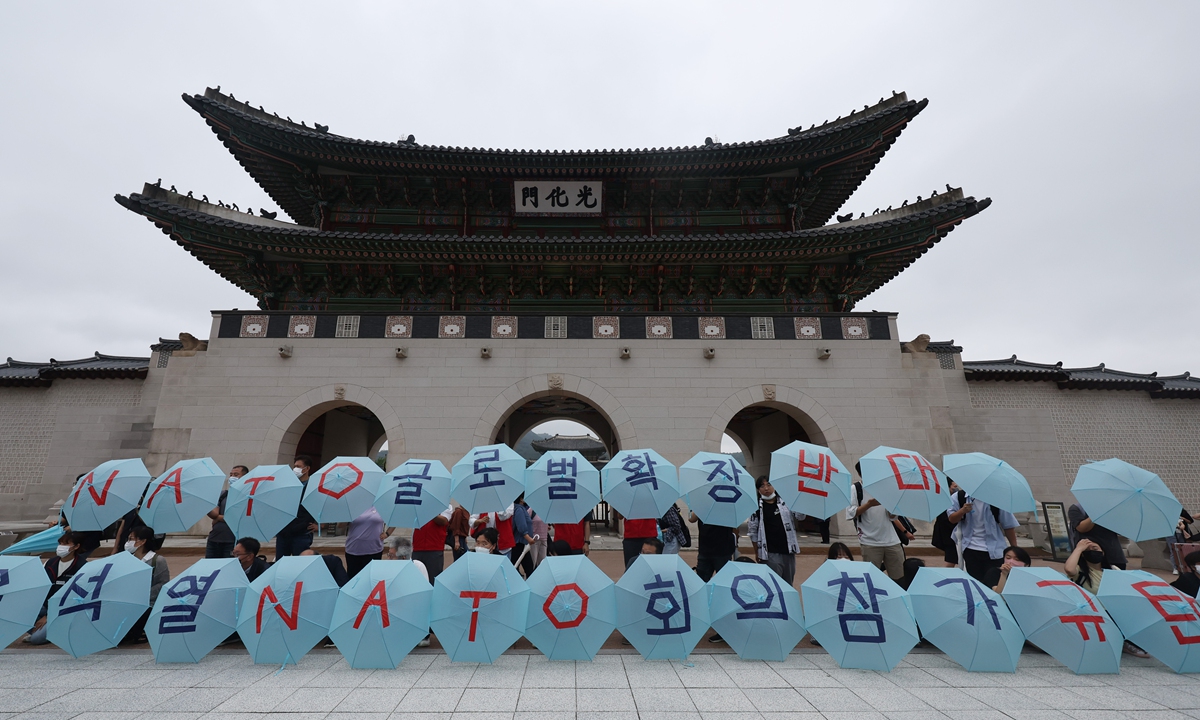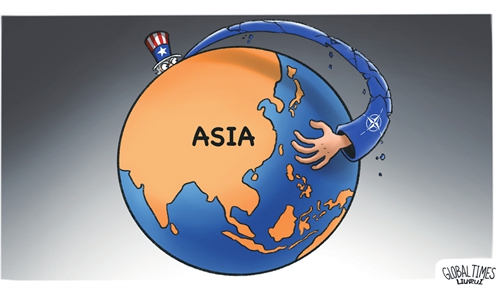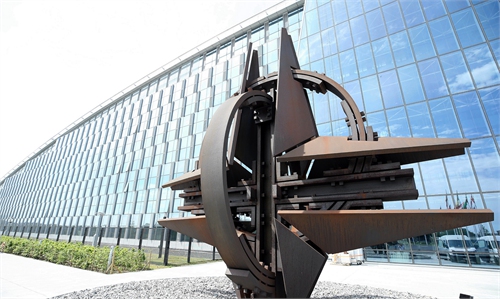IN-DEPTH / IN-DEPTH
NATO employs 30-year Europe-meddling ‘experience’ on Asia, meets with increasing opposition
Replicating division

South Koreans gather at Gyeongbokgung Palace in Seoul to protest South Korean President Yoon Suk-yeol's attendance of the NATO Summit on June 29. Photo: VCG
Editor's Note:
Amid the still ongoing Russia-Ukraine military conflict, NATO, which has been adding fuel to the conflict, held a three-day summit in Madrid, Spain, from June 28 to 30. The NATO alliance has been working to increase pressure on Russia over its conflict with Ukraine while underscoring their continued concerns about China. For the first time in history, Japanese and South Korean leaders were invited to attend the NATO Summit. The militant group which has already been a source of trouble for Europe is now trying to create its own Asia-Pacific chapter to interfere in Asia. How did the organization come about? How was it born from the Cold War mentality and gradually became an obstructor of world peace? Why is this military alliance extending its "black hand" to Asia? The Global Times will publish a series of four articles on how NATO is expanding. This is the last installment.

The leaders of four Asia-Pacific countries, namely Japan, South Korea, Australia, and New Zealand have a meeting in Madrid during the NATO Summit on June 29. Photo: VCG
In 1997, NATO formally invited Poland, Hungary, and the Czech Republic to join its ranks, laying the foundation for NATO's first eastward expansion in 1999 since end of the Cold War. In 2022, for the first time, the leaders of four countries - Japan, South Korea, Australia, and New Zealand - were invited to the NATO Summit in Madrid to seemingly set in motion NATO's expansion to the Asia Pacific.
A review of NATO's history shows that it first enlisted Western Europe against Eastern Europe and the Soviet Union, then united Eastern Europe against Russia, and now wants to pit Asia-Pacific countries against China. It is reasonable to say that as NATO expands eastward, it is creating divisions.
The first NATO Secretary General, Lord Ismay, stated the organization's goal was "to keep the Russians out, the Americans in, and the Germans down," and this speaks volumes about the role NATO has long played in Europe.
US tool to control Europe
In the 1990s, former US deputy secretary of state Strobe Talbott, who is responsible for NATO's expansion after the Cold War, repeatedly claimed that NATO, despite being a military organization, had a broad political function, and that its expansion was a powerful drive for the "Westernization" of member countries' political and social systems.
Indeed, for the US, NATO is undoubtedly a "security community" under the premise of ensuring Washington's absolute military superiority. This regional security architecture has three prominent features: The dominance of US hegemony, the hierarchy of states within the order, and explicit exclusionism.
For a long time, the vast majority of the US political elite have said openly that NATO is the US' most important strategic resource for ensuring its global hegemony. Without NATO, the US would lose the tools to control European countries, and it would be more difficult to promote the evolution of the security order in the Eurasian continent in line with the interests of US hegemony. Almost every major strategic shift in NATO's history has been US-led.
Since the end of the Cold War, the US and Europe have been at odds over whether NATO expansion should be limited to Europe or extend beyond it. However, from the strong intervention in the Balkan Wars in the 1990s, to the intervention in Iraq and Afghanistan in the 2000s, and the current more frequent involvement in Asia-Pacific affairs, NATO has breached the limits of only dealing with European affairs and constantly redefines its functions in line with the US' updated global strategy.
Bringing 'European division' to Asia-Pacific
In the past 10 years, NATO, through global partnership schemes, has pooled the resources of Asia-Pacific allies to focus on "dealing" with the Afghan issue, and accelerated coordination on security and defense with Japan, South Korea, Australia, and New Zealand.
Led by the US, NATO is rapidly applying the "experience" it has gained over the past 30 years in leading European security by creating divisions in Europe into the practical process of building security systems specific to the Asia-Pacific.
In recent years, while constantly trying to promote the integration of existing alliance mechanisms in the Asia-Pacific region, the US has been pushing NATO to fully establish itself in Asia-Pacific as soon as possible in terms of institutions and actions.
NATO Secretary-General Jens Stoltenberg has stressed on several occasions that NATO and its Asia-Pacific partners should strengthen practical cooperation in various areas, including maritime security and cyber technology.
When the leaders of Japan, South Korea, Australia, and New Zealand attended their first NATO summit in late June, the political message was clear: There will be more frequent and deeper coordination between NATO and US allies in the Asia-Pacific. The idea of expanding NATO to Asia plays an obvious role in the US' Indo-Pacific Strategy.
The US now hopes to adjust its existing alliance ties by strengthening small mechanisms so as to build a grand security system.

South Korean activists hold a rally near the president's office on June 28 to protest against NATO's invitation of Asia-Pacific countries' leaders to the NATO Summit. Photo: VCG
NATO-led security system aimed at containing China
As its strategic focus continues to shift eastward, the US has significantly accelerated the pace of the layout of the Asia-Pacific security framework. On the one hand, the US is pushing Asia-Pacific countries including Japan, South Korea, Australia, and New Zealand to strengthen ties and cooperation with NATO. On the other hand, US dignitaries including President Biden have also visited other Asia-Pacific countries frequently, creating an international atmosphere of "Sinophobia" and promoting the alignment of the security and defense strategies of the visited countries with NATO. Through these means, the US wants to accelerate the formation of a regional and even global security system with NATO at its core to contain China.
Such moves taken by the US are similar to what the US has been doing in Europe to aggravate the conflict between NATO countries and Russia. The eastward expansion of NATO has led to the Russia-Ukraine conflict in Europe as well as the last confrontation between Russia and NATO, and the great division of Europe. So the "Asianization" of NATO, led by the US, will be disastrous to the Asia-Pacific region and undermine regional peace and prosperity. This military alliance will force Asia-Pacific countries to take sides between China and the US based on its logic of great power geopolitical competition, leading to increasingly intense regional crises and conflicts in the Asia-Pacific region, and it is likely to cause a major security and economic split in the Asia-Pacific region, thus severely interrupting the process of regional economic integration.
According to the 2022 Strategic Concept adopted at the NATO Summit in Madrid (June 29-30), the military alliance has three core tasks over the next decade: Deterrence and defense, crisis prevention and management, and cooperative security. In terms of deterrence and defense, the US and its allies are increasing military spending, which will trigger an arms race in multiple regions and lead to regional tensions. In terms of crisis prevention and management, we must remember that NATO has carried out so-called "crisis prevention and management" in Yugoslavia, Iraq, Afghanistan, and other countries, and the consequences of these actions by Washington are obvious to the whole world. In terms of so-called "cooperative security," if NATO wants to strengthen its presence in the Asia-Pacific region, it is likely to create a serious crisis in the Taiwan Straits and the South China Sea.
In this process, its so-called global partnership will be rapidly advanced. This process will also change the internal political, economic, and social systems of other countries. In the complex Asia-Pacific region, NATO's approach will inevitably lead to contradictions and conflicts.
Undermining UN authority
If the "Asianization" of NATO proceeds smoothly, a global NATO security pattern will eventually emerge. This will be at the heart of the US' global security blueprint, but it is not something that truly peace-loving nations would like to see.
The North Atlantic Treaty states that the Parties to this Treaty reaffirm their faith in the purposes and principles of the Charter of the United Nations and their desire to live in peace with all peoples and all governments.
NATO also claimed its "collective defense" commitment is based on the right of individual and collective self-defense guaranteed by Article 51 of the United Nations Charter. However, NATO waged the Kosovo war without UN authorization and it tampered with the UN resolution to launch a regime change war in Libya and constantly conducted military operations outside its defense zone.
All these activities have demonstrated that NATO's missions and operations are a complete departure from the UN Charter. The organization has become increasingly offensive, and a "weapon" and accomplice of US hegemony.
NATO is creating new divisions and bloc confrontations in the Asia-Pacific region by grading countries based on its own needs. This year, NATO hosted several meetings and the Madrid Summit to discuss the institutional arrangement of strengthening coordination with US allies in the Asia-Pacific regions. These meetings, without exception, hyped the "China threat."
NATO's recent reiteration of the importance of establishing and setting international rules is noteworthy. It is true that the lasting stability of state-to-state relations cannot be achieved without adherence to international rules by all parties. However, a military alliance that advocates the theories of "civilization superiority" and "sovereignty relativity," and meddles in bloc politics is unlikely to promote rules recognized by the vast majority of countries in the world. The future global security system must not be built around the alliance system of "global NATO," but must return to the rational and healthy way of consolidating the core role of the UN.



